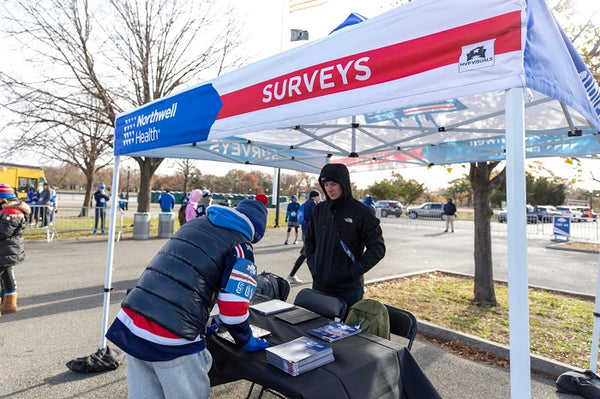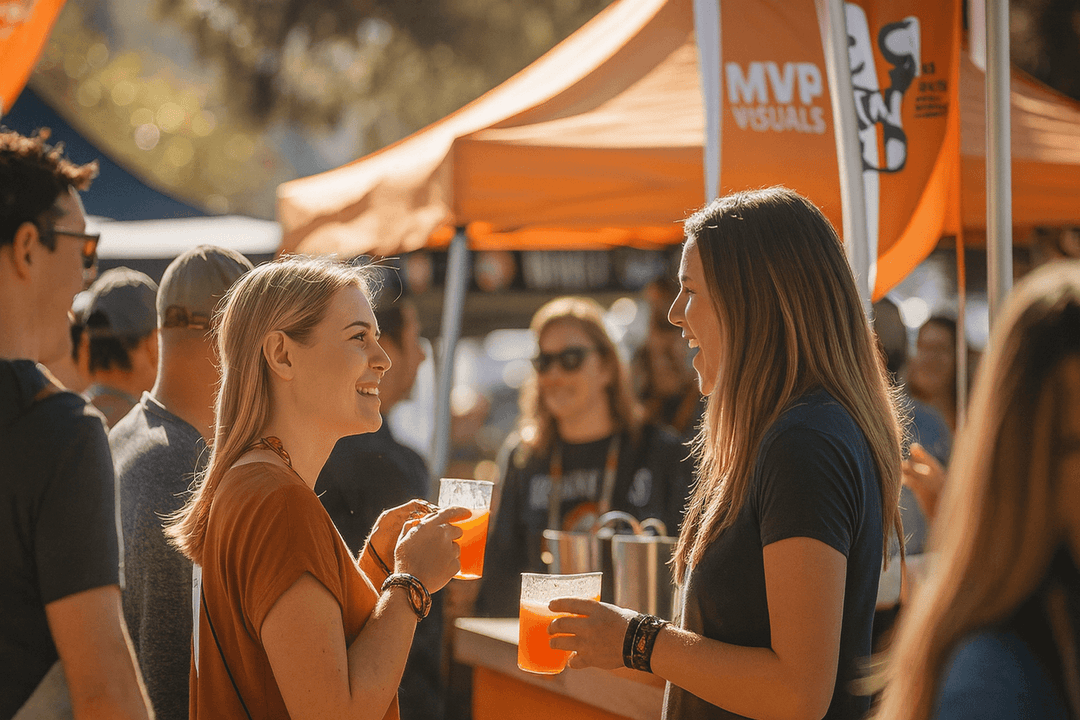You’ve done the research on the best custom pop up tent for your brand and you’re ready to invest in custom event marketing that will tell your story. The only problem is, none of the research you’ve done on tent canopy fabrics or pop up tent frames have given you insight into custom tent design. Custom printed tent design isn’t the same as printing a poster or designing an infographic for Facebook. There are special considerations to take into account, from how your brand’s colors will look when printed on 300 Denier or 600 Denier polyester to how well your design will stretch and fold with your tent. Ideally, you’ll work with a manufacturer who is well versed in all of these complexities, but the more you know going into those conversations, the better prepared you’ll be to help design your custom tent. That’s why we’ve put together this guide to help you learn the best practices when designing your custom pop up tent.
Choosing Custom Pop Up Tent Colors
The first step to designing your custom pop up tent is choosing your colors. Whether you’re printing a custom tent with logo or a fully printed tent with detail on every square inch, the colors decide whether you stand out at your next event or are passed by for the stall next to yours. When it comes to selecting your colors, it’s not as easy as telling the printer if you want red or blue. Not only do you need to choose colors that will enhance your brand image, but you also need to choose tones that will print well and not look washed out once they’re translated to fabric.
Choosing Colors for Brand Consistency
The number one goal of your custom printed advertising tent is to draw customers to your tent to learn about your brand. For that to work, your tent needs to be consistent with your brand. In rare circumstances, you can choose tent colors that are event specific, but most of the time your tent colors should be in keeping with your brand’s colors. This creates consistency from event to event, and will also create a cohesive look with any branded marketing materials you may have inside your custom pop up tent.

Although you want to choose colors that match your brand, you may need to be creative about how you use those colors when printing a custom tent. For example, while many brands print their logos on white backgrounds, printing your custom tent logo on a white background is rarely a good idea. White tent canopies rarely stay white long, and once they become grungy, your entire brand looks a little worse for the wear. Customers are more likely to engage with vendors using tents that look sturdy and well-maintained. To keep that coveted well-maintained look for your tent, you might need to choose a color for your canopy background or even do an inverse logo where you print your logo in white and your tent canopy in your usual logo color.
Printing Pantone Colors vs. CMYK Colors
When it comes to choosing your colors, the next step is to select the exact ride shade. If you can use Pantones rather than CMYK, they’ll come out better during production. Pantones match more closely with digitally produced colors, and their printed form is more consistent across different textiles than CMYK.
Choosing Pantones over CMYK colors is especially important if you’re purchasing multiple marketing materials, such as a custom pop up tent and a table cover. The CMYK four-color mix may absorb differently into a polyester tent canvas versus a spandex table cover, for example. Choosing Pantones makes you color decisions look consistent and intentional across all of your branded marketing materials. This makes your brand look more professional and reliable to your potential customers.
Design Custom Tent Messaging

The goal of your custom printed tent is to communicate with your customers. What message you communicate and how you communicate that message is dependent on a number of factors, including your budget and the purpose of your tent as well as the nuances of tent design.
Budgetary Constraints and Messaging
Depending on your budget, you may have limits to how much you can do with your event messaging. For example, you may be limited to just using one color or only printing on certain spots on your tent. Be sure to communicate with your tent manufacturer to see how your budget impacts what you can do with your brand messaging before you start putting together a design. It’s much easier to design with constraints in mind than to try to reel in a design that has gone too far.
Regardless of your budget, keep in mind that branded pop up tents have more visitors at events than unbranded pop up tents. That means that you want to ensure you’re investing in a custom pop up tent of some sort, even if the customization is just your logo on a plain background.
The Purpose of Your Custom Canopy
The next step in custom tent design is realizing the purpose of your tent. Printed tents that are designed to be brought from event to event to increase brand exposure and recognition look different than customized tents that are brought out for a single annual event.

If you are bringing your trade show tents to multiple locations, you need a generalized message. In these cases, a custom tent with logo is often a good idea as it can increase brand recognition while remaining versatile for any type of event you may attend.

On the other hand, if your tent is for something specific, it can be good to customize your message a little further. Place a pink ribbon around your logo for a breast cancer awareness charity event or customized pop up tents for track and field events. In these instances, the added touch can help your tent stand out against the more generalized tents around it, giving you a little more bang for your buck.
Designing Around Creases and Folds
Creating your tent design isn’t as simple as designing one rectangular image and having it printed on a canvas. You have to keep in mind how the canvas is actually going to sit on your tent frame. Many manufacturers will have templates to help you create tent designs that work, but even within those templates, there are some best practices to keep in mind.
- Use the Valance for Eye-Level Design. The valance, or the horizontal strip that hangs directly over your table, is seen most easily by people right in front of your table. This makes it a great location for information you want to give to people who are already at your table, such as your website, phone number, or social media handles.
- Use Peaks for Distance Design. The peaks, or the large triangles at the top of the tent, are the part of your tent that people can see from far away. This is where the majority of your distance advertising should be focused. Often, you'll see large logos on the peaks. Other choices are to print the name of your brand here, a picture of your product, or an image of your mascot. Whatever you choose to print on your peaks should draw people toward your tent.
- Ask About Tent Placement. If you're designing a tent for one specific event, ask the event coordinator where your tent will be positioned. If you're going to be tucked into a corner or pressed up against other stalls, you can forego printing on side valances - but if people will be able to access your table from 360 degrees, you'll want to be sure to advertise accordingly.
Custom Printed Tent Hardware

If you have the budget to really make your tent above and beyond, consider purchasing with a supplier that offers customization right down to the hardware. Instead of choosing standard white powder-coated steel or silver aluminum frames, you may be able to choose a frame in a color that accents your tent canopy design. This can put you just that little bit ahead of your competition when it comes to standing out at major events. Just keep in mind that every additional level of customization comes with a price tag.
A Final Note on Customized Tent Design
No matter how much work you put into designing the perfect custom tent, your tent is only as good as the manufacturer that makes it and the care you take to preserve it. Always work with a manufacturer you trust. Saving a few dollars isn’t worth it if it means purchasing a tent that is poorly printed or shoddily made. Check a manufacturer’s reviews and history of success to be sure you can trust them before making a purchase. Once your tent is in your hands, follow manufacturer instructions for set-up, care, and cleaning to protect your investment and help your tent live its longest possible life.
At MVP Visuals, we're proud to have more than a decade of experience with designing and printing custom tents with logos. Visit our custom tents collection to shop online or request a quote today to speak with a rep in-depth about your next project!




